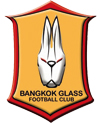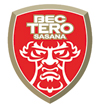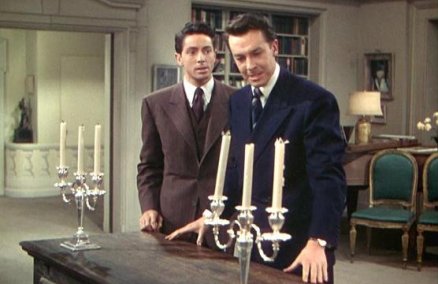
The buzz: This project was spearheaded by a partner of Minibar Royale, whose family also owns Suppanniga, a charming boutique hotel in Khon Kaen. Now, he’s bringing his Isaan roots to Bangkok in the shape of this somtam-focused restaurant. The objective is to steer our taste buds back towards Northern Isaan, and away from the sweeter flavors that Bangkokians so cherish.
The décor: Somtum Der belies its basic shophouse shell. It’s got a little mezzanine which lets in plenty of light, ably supported by the white walls and blonde wood. A red accent wall, the central somtam bar and craft-inspired bamboo lamps add a bit of warmth and Isaan flavor to the mix.
The food: Chef Kornthanut Thongnum, although originally from the North, lived eight years in Sakon Nakhon, which is way up there, just beneath Nong Khai. He says the somtam pla ra there is not sweet at all, and that he’s trying to win Bangkokians over to this flavor. (His only compromise is to pasteurize the pla ra for our weak stomachs.) Of the score of varieties available, standouts include his tam sua Sakon Nakhon (B65), which comes with freshwater crab and kratin beans, and the tam pla tu khao man (B85), which comes with mackerel and is served with a side of rice cooked in coconut milk. And of course, there’s a long list of usual suspects, from laabs to tom saep.
The drinks: Beerlao dark should be coming in soon, but we’re particularly excited by their martinis (B99). Made by infusing vodka with lemongrass or roselle, they pack quite a punch and remain fairly dry.
The crowd: Lunch sees expats and executives who don’t mind paying extra for somtam with air-con, while dinner draws a mixed crowd including some boys headed to Silom Soi 2.
5/5 Saladaeng Rd., 02-632-4499. Open daily 11am-10pm.

The buzz: Another wine bar, you moan. But wait, this one isn’t doing the usual Italian fusion thing. Instead, it’s all about pairing wines with Isaan cuisine, a notoriously difficult entreprise.
The décor: Located on the second floor of a blue house in community mall Nawamin Festival Walk, Noreste is decorated with bird cages, old-school tiles and French windows, which combine to create a European country house atmosphere. There’s also a deck where you can smoke shisha with flavors like apple, grape and mint (B400).
The food: Here too, the owner promises to bring full-on Isaan flavors. You can start by trying the chicken wings stuffed with laab (B150), or opt for some popular dishes like somtam kai kem pla duk foo (papaya salad with salted egg and deep-fried catfish, B160), laab salmon (salmon in herbal sauce, B320) and grilled lamb (B450). They even have jim joom (Isaan hotpot, B480), just like on the street, but with Ko Khun beef (a renowned beef from Isaan).
The drinks: Over 40 labels of red, white and sparkling (mostly Italian wines) starting from B650 while classic cocktails are B180.
The crowd: Shoppers, couples on dates and trendy families.
Room J201-202, 2/F, Nawamin Festival Walk, Kasetnawamin Rd., 02-907-0858. Open daily 4pm-2am.

The buzz: Owned by the familiar faces from Blue Velvet, Extra Virgin and Surface, Café Chili Zaap might remind you of Café Chili in Siam Paragon, but they promise this place will not make the same compromise on fiery flavors for the hi-so crowd.
The décor: With a grey palette, an illustrated monochrome wall and modern furniture, this Café Chilli is a far cry from the jungly vibe of the Paragon branch. It’s almost like they were going for a Greyhound look then threw in the textured walls, wicker lamps and rivets lining the furniture to remind us of their upcountry menu.
The food: A range of classics like gaeng lao hed tob (earth star mushroom in Northeastern soup, B150) and tam sua (papaya salad mixed with rice vermicelli and bean sprouts, B95) is complemented by some Isaan-style fusion like the soup noh mai (spicy bamboo shoot salad, B180) topped with grilled salmon or the recommended spaghetti with Isaan style sausage (B150).
The drinks: Herbal drinks like roselle juice (B75) and lemongrass juice (B75). But if you’re ready for booze in a mall, they also have classic cocktails (B140-B180). Beers are Heineken (B110) and Singha (95).
The crowd: It’s in a mall, so mostly Thai families and couples.
1/F, Central Ladprao, 1691/1 Paholyothin Rd., 02-541-1485. www.cafechilli.com. Open daily 10am-10pm.

The buzz: The former owner of boutique hotel Eugenia sold up, and moved along Sukhumvit to the same small dead-end soi that is home to Casa Pagoda and the soon-to-open Quince. There, this interior designer created a purpose-built colonial-style hotel, with more than a touch of the English country house about it. Despite these design themes, the restaurant is resolutely Thai, focusing on dishes you’re more likely to find at a roadside stall than an elegant boutique hotel.
The décor: A blend of Thai mixed with a touch of 1920s Shanghai. That means wooden walls taken from an original Thai house combined with tiled floors, marble top tables, lots of dark wood and plenty of antique bric a brac and furniture. There is also an Edwardian-style private drawing room for intimate dinner parties.
The food: No fusion, no added sugar and no holding back on the spices, just an extensive menu of classic and authentic Isaan, Northern and Laotian dishes, with the occasional Southern offering as well. Recommended dishes include the gai yang takrai, (deep fried chicken wings with lemongrass, B120), the fresh and aromatic laab Laos (B150), and the kow pad Thai Lao Yeh (B180) that mixes seafood, pork and more with the fried rice. There are also plenty of harder to find Northeastern treats like kob tod (deep fried frog, B160) and gaeng pak wan kai-mod-daeng (spicy soup with ants eggs, B160).
The drinks: The presence of the Joy Luck Club bar in the hotel means you can enjoy cocktails mixed by bar staff dressed in 1920s style outfits, who have previously worked at Zuma and Hyde & Seek. The seasonal signature cocktail is currently the Star Ruby (B280), vodka, roselle, amaretto, and mangosteen.
The crowd: Hotel guests and a growing number of inquisitive well of locals coming to check out the new arrival to this increasingly happening foodie neighborhood.
14/29, Sukhumvit Soi 45, 02-259-2871-3. BTS Phrom Phong. Open daily 11am-2pm, 6-10:30pm.
 Stadium: SCG
Stadium: SCG  Stadium: Chaeng Wattana Stadium, Lak Si
Stadium: Chaeng Wattana Stadium, Lak Si  Stadium: Leo Stadium, Pathum Thani
Stadium: Leo Stadium, Pathum Thani Stadium: Thammasat Stadium, Rangsit, Pathum Thani
Stadium: Thammasat Stadium, Rangsit, Pathum Thani Stadium: Thephasadin Stadium, Pathumwan
Stadium: Thephasadin Stadium, Pathumwan Stadium: PAT Stadium.
Stadium: PAT Stadium. 
























